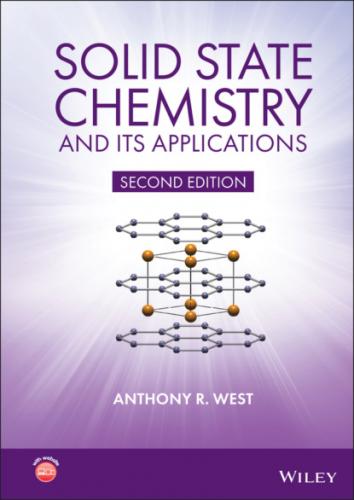At x = 0.3125, the B coordination becomes undistorted octahedral and the BX6 octahedra link by sharing corners to form a 3D network. The A coordination may be described as 2X′ + 6X, with short A–X′ bonds. These A–X′ bonds form a 3D network, A2X′, that interpenetrates the network of BX6 octahedra, of stoichiometry B2X6. The A2X′ net, with linear X′–A–X units and X′A4 tetrahedra, is similar to that in cuprite, Cu2O. The B2X6 and A2X′ networks, that together form the pyrochlore structure, are shown separately in Fig. 1.48.
Pyrochlore‐based oxides have a range of interesting properties and applications. La2Zr2O7 is an electronic insulator whereas Bi2Ru2O7‐δ is metallic and Cd2Re2O7 is a low temperature superconductor. (Gd1.9Ca0.1) Ti2O6.9 is an oxide ion conductor and Y2Mo2O7 is a spin glass. As indicated in some of the above examples, the anion content is not always 7 and indeed the amount of X′ in the general formula can have values between 0 and 1 in different pyrochlores.
Figure 1.47 Some cation‐ordered fluorites showing cation positions relative to those in fcc fluorite.
A. F. Wells, Structural Inorganic Chemistry, Oxford University Press (2012).
The rare earth oxides RE2O3 have structures derived from oxygen‐deficient fluorite in which the rare earth CN is reduced to 7 or 6. There are three structure types stable below 2000 °C: hexagonal A, monoclinic B and cubic C (or bixbyite) with A favoured by larger cations La to Pm, C by the smaller cations Gd to Lu and B by those of intermediate size. Some oxides are polymorphic and transform in the sequence C to B to A with increasing temperature, although most do not form all three polymorphs. Structure types and polymorphisms are summarised in Fig. 1.48(b) with part of the structure of A‐type La2O3 in (c) showing 7‐fold coordination of La in the form of a distorted cube with one corner missing. The B structure is a monoclinic distortion of A giving rise to a mixture of 6‐ and 7‐coordinate RE cations whereas the C structure has 6‐coordinate cations. The mineral name of the C structure is bixbyite, (Fe,Mn)2O3 and it is essentially cubic fluorite with ¼ of the oxygens missing.
The weberite structure, Na2MgAlF7, is another anion-deficient fluorite superstructure, closely related to pyrochlore that is shown by a range of fluorides and oxides of general formula A2B2X7. The ideal symmetry of weberite is orthorhombic, space group Imma, but several structurally-related polymorphs occur, depending on composition. The anion-deficiency relative to fluorite leads to an overall reduction in cation coordination number with two types of distorted AX8 polyhedra and two sets of BX6 octahedra. It may be regarded as a 3D network of corner-sharing BX6 octahedra, but also as a complex interpenetrating network of corner- and edge-sharing AO8 polyhedra within which the anions occupy three sets of crystallographically-distinct tetrahedral sites. The cations in isolation form ccp layers, equivalent to those in the (111) orientation in fluorite and pyrochlore, but have two stoichiometries, A3B and AB3, that alternate. The A components of these layers also form a so-called Kagome network of interlinked hexagons and triangles which may be regarded as cp layers with ¼ of the packing atoms absent.
Figure 1.48 The pyrochlore structure, which may be regarded as a distorted, 2 × 2 × 2 superstructure of a cation‐ordered, anion‐deficient fluorite. Anions in eightfold positions, e.g. in fluorite split into two groups in pyrochlore, with one group, X, in 48‐fold positions at e.g. (x, 1/8, 1/8). (b) Temperature‐dependent polymorphism of the rare earth sesquioxides.
G. Adachi and N. Imanaka, Chem. Rev. 98, 1479 (1998).
(c) part of the C-type La2O3 crystal structure showing 7-coordinate La.
A range of complex oxides have weberite structures, in compositional families such as Ln3NbO7, better written more informatively as Ln2(Ln, Nb)O7: Ln = La, Nd, Gd, Dy; Ln2B2O7: LnB = NdZr, SmTi; A2Sb2O7: A = Ca, Sr, Pb and Ca2(Ta, Nb)2O7 (see L Cai and JC Nino, Acta Cryst B 65, 269 (2009) for more details). Weberite oxides are of interest, showing a diverse range of electrical properties. Various weberite fluorides are known, with Na or Ag as the A-cations and different divalent, trivalent B cation combinations such as B2+: Mg, Mn, Fe, Co, Ni, Cu, Zn and B′3+: Sc, V, Cr, Fe, Al, Ga, In, Tl; most interest is in the magnetic interactions associated with the different transition metal combinations in the B sites within the Kagome A sublattice.
1.17.13 Garnet
The garnets are a large family of complex oxides, including both minerals and synthetic materials, some of which are important ferromagnetic materials; yttrium aluminium garnet (YAG) is used as a synthetic gemstone and when doped with neodymium is the key component in YAG lasers; more recently, garnets with high Li+ ion conductivity have been synthesised; garnets have hardness 6.5–7.5 on the Mho scale and are used industrially as an abrasive on sandpaper. They have the general formula A3B2X3O12: A = Ca, Mg, Fe, etc.; B = Al, Cr, Fe, etc.; X = Si, Ge, As, V, etc. A is a large ion with a radius of ~ 1 Å and has a coordination number of eight in a distorted cubic environment. B and X are smaller ions which occupy octahedral and tetrahedral sites, respectively. Garnets with A = Y or a rare earth: Sm, Gd, Tb, Dy, Ho, Er, Tm, Yb or Lu and B, X = Fe3+ have interesting magnetic properties. One of the most important is yttrium iron garnet (YIG), Y3Fe5O12, the structure of which is shown in Fig. 1.49. Many other A, B, X combinations are possible, such as those in Table 1.25.
Figure 1.49 The garnet crystal structure.
The unit cell of garnet is body centred cubic, a ≈ 12.4 Å, and contains eight formula units. The structure may be regarded as a framework built of corner‐sharing BO6 octahedra and XO4 tetrahedra. The larger A ions occupy eight‐coordinate cavities within this framework. In YIG and the rare earth garnets, the B and X ions are the same, Fe3+.
